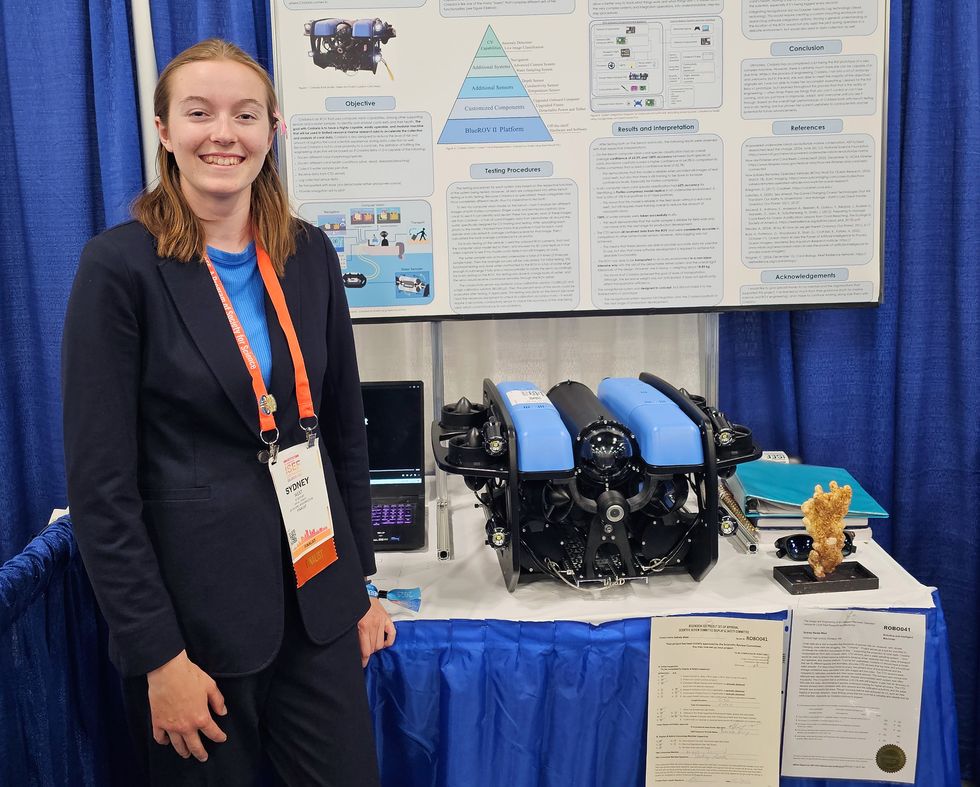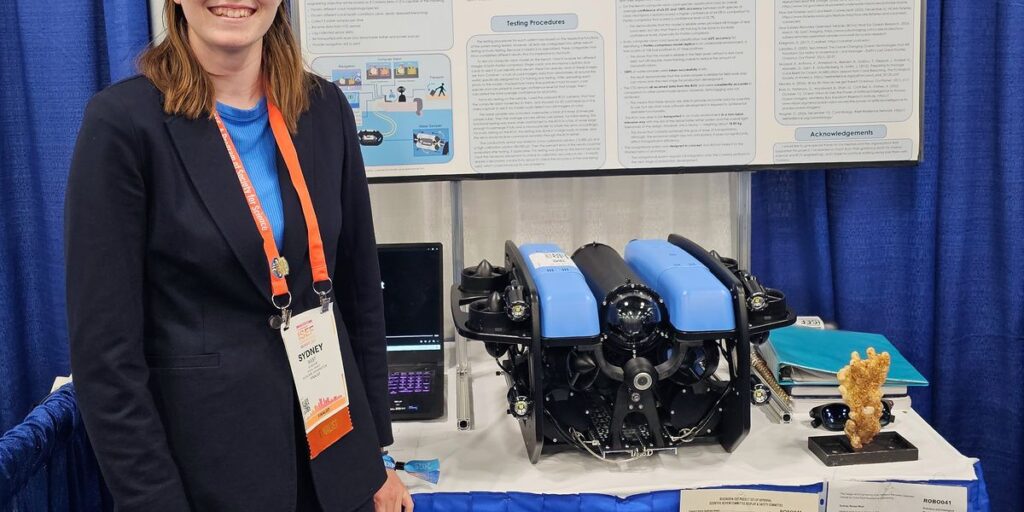
Coral reefs are vital to marine ecosystems, supporting more species than any other ocean environment. More than 80 percent of the planet’s coral reefs have been bleached due to rising ocean temperatures and pollution, according to the U.S. National Oceanic and Atmospheric Administration. The reef damage threatens marine biodiversity across the globe.
High school student Sydney West built a remotely operated vehicle (ROV) designed to help preserve and sustain coral reefs. West, a graduate of Hanford High in Richland, Wash., and an incoming freshman at the University of Hawai’i at Manoa, plans to pursue a degree in mechanical engineering.
Her project, The Design and Engineering of an Intelligent Remotely Operated Vehicle for Coral Reef Research and Monitoring, was showcased in May at Regeneron’s International Science and Engineering Fair, held in Columbus, Ohio.
West won this year’s IEEE Presidents’ Scholarship of US $10,000 for her underwater vehicle, Cnidaria. The award is payable over four years of undergraduate university study and includes a complimentary IEEE student membership. Ramy Tantawy, chair of the IEEE Columbus Section, presented West with the scholarship.
The IEEE Foundation established the Presidents’ Scholarship to acknowledge a deserving high school student whose project demonstrates an understanding of electrical engineering or another IEEE field of interest. The scholarship is administered by IEEE Educational Activities.
The second-place winner received a $600 scholarship; the third-place winner received a $400 scholarship. Both also got complimentary IEEE student memberships.
Computer vision and sensors identify coral species
The ROV’s name, Cnidaria, comes from the taxonomic family name for coral species. When discussing the project, West affectionately refers to the drone as “she,” a nod to the nautical tradition of personifying vessels, as well as a reflection of the deep connection and pride she feels for her work.
Cnidaria is equipped with computer vision technology, conductivity, temperature and depth sensors, and a water-sampling system. The vehicle is capable of identifying a variety of coral species, detecting anomalies among them, collecting water samples, and logging data about the water’s condition.
West describes the ROV as versatile. “Each of her systems can be modified, detached, or replaced easily,” she says. The vehicle can be customized for different research needs.
“Never be afraid of failing. Failing is not the end. If you’re not failing, you’re not learning.”—Fay Salim al-Mahrouqi
West plans to add a data-logging system and a navigational aid, a Doppler velocity log, to help researchers more accurately track coral locations and streamline data collection.
“I want her to be a tool for all researchers who study coral to improve their efficiency, and make it easier for them to focus on their research and not have to worry about all of the labor-intensive and logistical hassles,” West says.
West intends to launch a business offering services for ROV users, including refurbishing the drones, selling parts and systems, and offering training courses to those who want to build their own marine vehicles.
After completing her bachelor’s degree in mechanical engineering, she plans to attend graduate school to study marine biology.
“I want to get the best of both worlds,” she says. “Having knowledge about the principles of engineering, and also what I’m engineering for, will help me strengthen my work in the field.”
West advises budding engineers to cultivate tenacity.
“Things will go wrong,” she says. “You’ll hit roadblocks and obstacles, and spend days or weeks trying to solve a single problem, but that consistent effort and determination are key to eventual success.”
Fay Salim al-Mahrouqi, a high school senior at the Dohat al-Adab School in Muscat, Oman, took second place for her project, A Hybrid Learning-Driven Approach for Lung Enhancement, Tumor Detection, and Fibrosis System.
Al-Mahrouqi’s inspiration stemmed from the loss of her grandfather to idiopathic pulmonary fibrosis. IPF is a chronic disease that develops when lung tissue becomes too thick, causing permanent scarring in the lungs, according to the U.S. National Heart, Lung, and Blood Institute. The condition makes it hard to breathe. Despite numerous hospital visits and CT scans, her grandfather was diagnosed with the condition too late, leading al-Mahrouqi to want to improve IPF diagnosis methods.
“Radiologists look for things like tiny, honey-shaped complex sites or faint, hazy areas called ground-glass opacities in the lungs,” al-Mahrouqi says. “These same patterns also show up in other diseases, like nonspecific interstitial pneumonia and early-stage lung cancer. This often leads to a misdiagnosis.”
She developed a hybrid artificial intelligence system that uses a contrast-limited adaptive histogram equalization process, enhancing CT images by amplifying contrast and limiting image grain. Her prototype also uses six different pretrained convolutional neural networks that classify fibrosis patterns and nodule types—malignant, benign, or normal—to provide an earlier diagnosis.
“This prototype is unique because it converts classification and enhancement into a single diagnostic tool,” al-Mahrouqi says. She says it is the first time machine learning techniques have been used to target fibrosis patterns.
She is collaborating with hospitals to collect more patient data to help her improve the accuracy of her diagnostic tool.
Al-Mahrouqi says she is committed to advancing her project: “The process of inventing something is not about entering a competition. It’s about solving real-world problems. What’s the point of working on a project if you are not willing to continue to develop it?”
She says she hopes to launch a startup to commercialize her technology, with the goal of achieving worldwide adoption by hospitals. In the meantime, she says, she plans to dedicate her senior year to studying entrepreneurship and will pursue a degree in data science, cybersecurity, or electrical engineering.
Her advice to young engineers is: “Never be afraid of failing. Failing is not the end. If you’re not failing, you’re not learning.”
A stethoscope to identify multiple body sounds
Kayley Xu, a junior at the Bishop’s School in La Jolla, Calif., took third place for her Wearable Stethoscope Array for Cardiopulmonary Sound Localization and Interference Suppression Using Beamforming project.
When Xu was 13 years old, she had a severe case of pneumonia. “During the diagnosis and treatment process, I observed limitations with some of the medical equipment, such as the stethoscope,” she says.
That experience inspired her to pursue respiratory disease research, specifically the performance of auscultation: listening to the body’s internal sounds.
Through her research, she discovered that traditional stethoscopes have limitations including a doctor’s inability to listen to multiple sounds simultaneously—which creates interference when they overlap.
Xu designed a chest piece using a flexible printed circuit board that conforms to the patient’s body. The piece uses a microelectromechanical microphone capable of capturing a wide range of frequencies. By combining novel hardware designs with beamforming—a signal processing technique—Xu says the device “can capture both low- and high-frequency range sounds such as lung crackles and heart murmurs, which are often missed by conventional stethoscopes.”
The sensor in her device detects where a sound is coming from more accurately without sacrificing audio quality. The device also is more affordable than a standard stethoscope, she says, as its flexible printed circuit board can be produced for less than US $1 per unit when manufactured at scale.
“I hope my device will enable more underdeveloped regions around the world to have broader access to stethoscopes and more cost-effective processes,” she says.
Her project not only helped her advance her technical skills but also taught her the importance of perseverance, creativity, and innovation, she says.
As she heads into her junior year of high school, she plans to continue developing her device. She also intends to pursue an engineering degree.
Her advice to young engineers? “Have a lot of grit and perseverance.”
From Your Site Articles
Related Articles Around the Web
Disclaimer: This post is sourced from an external website via RSS feed. We do not claim ownership of the content and are not responsible for its accuracy or views. All rights belong to the original author or publisher. We are simply sharing it for informational purposes.
